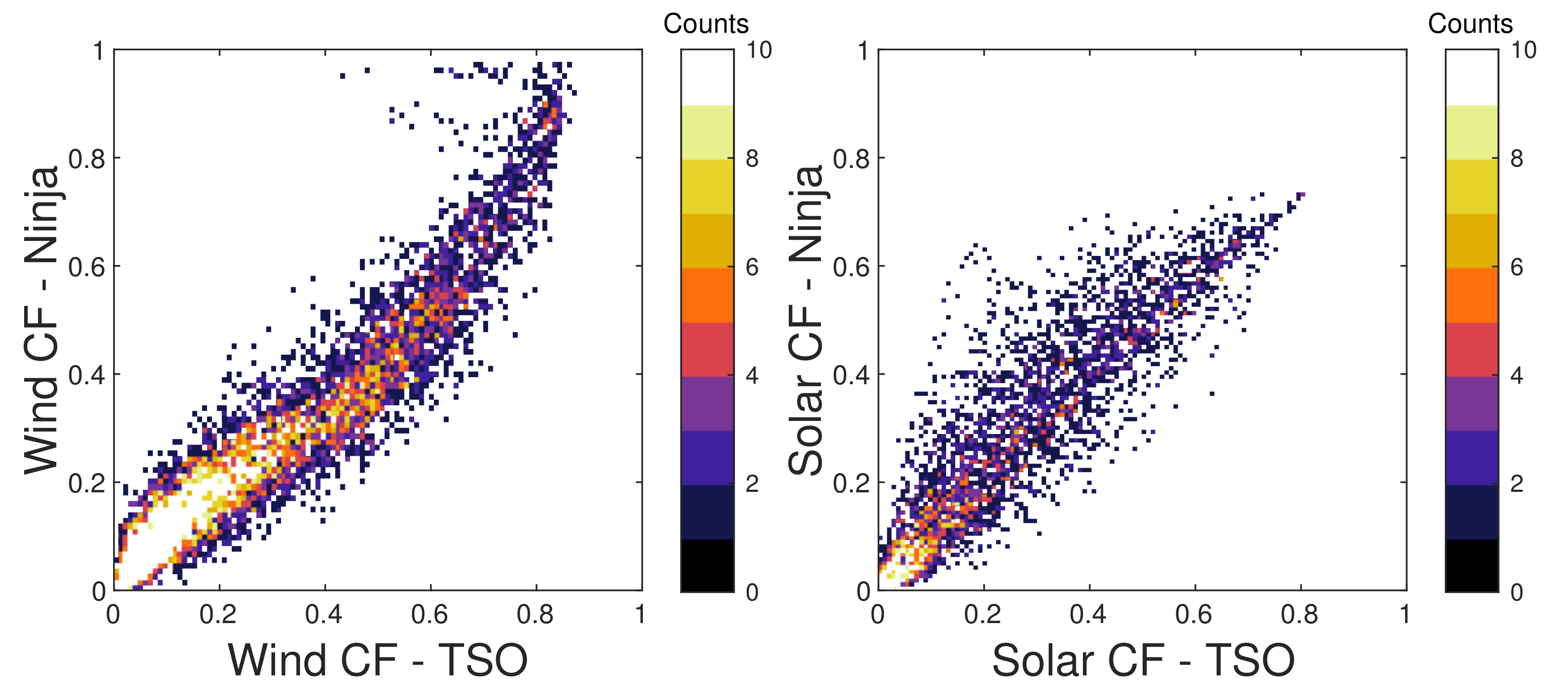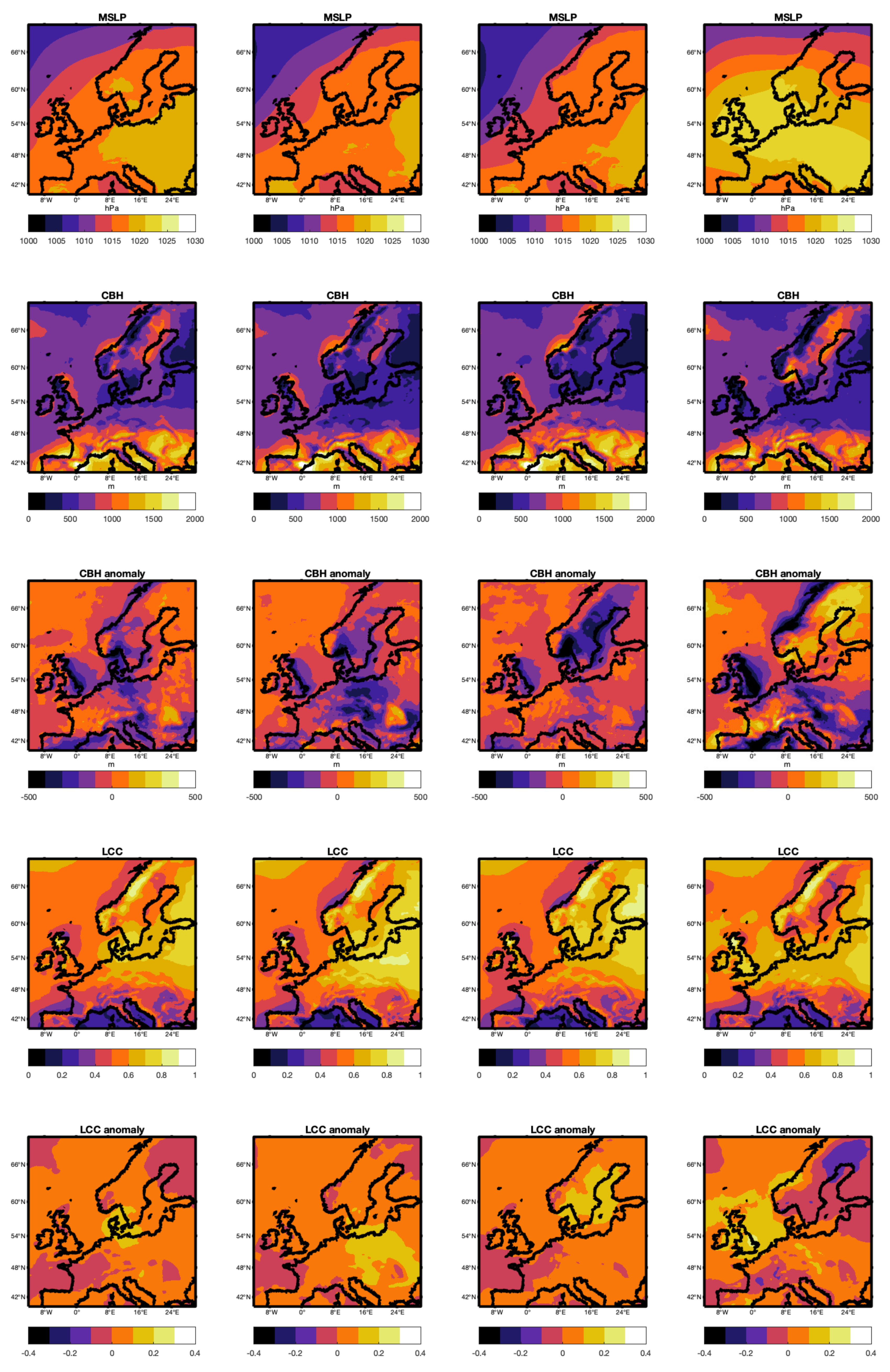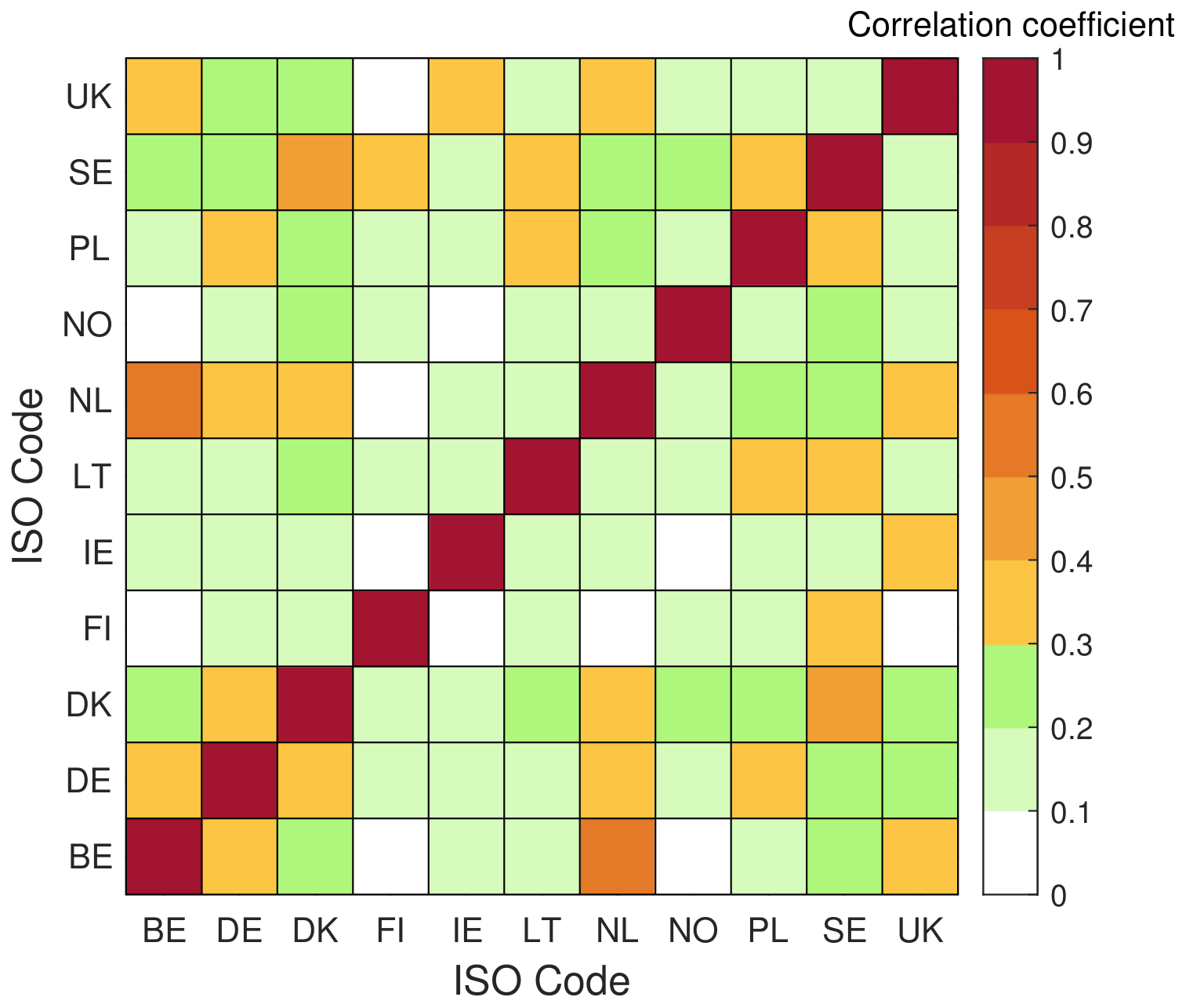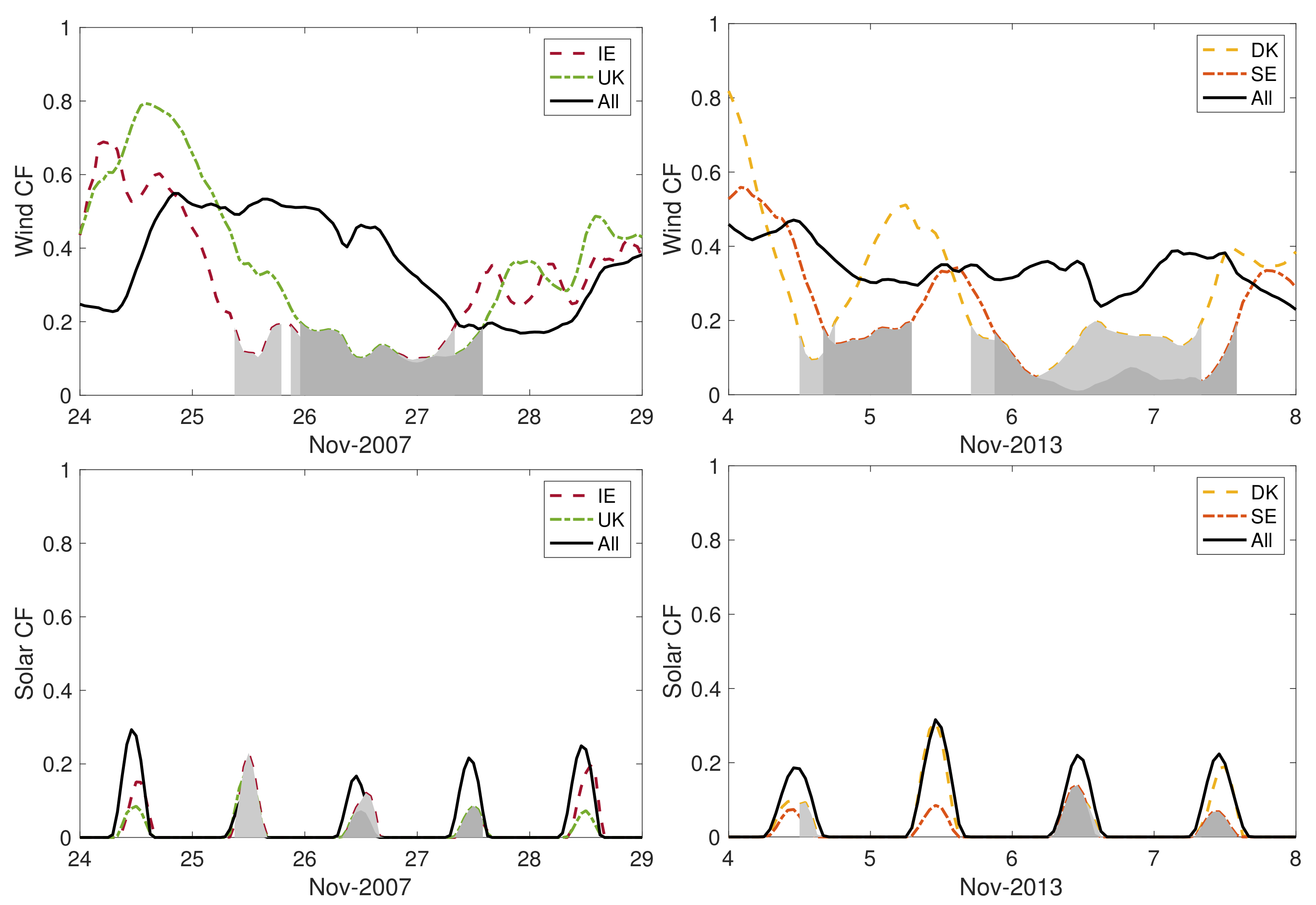A Brief Climatology of Dunkelflaute Events over and Surrounding the North and Baltic Sea Areas
Abstract
1. Introduction
2. Data and Methods
2.1. Simulated Power Production Data
2.2. Validation of Simulated Power Production Data
2.3. Reanalysis Data
3. Characteristics of Wind and Solar Power Generation during Dunkelflaute
4. Meteorological Drivers
4.1. Pressure
4.2. Cloud
5. Spatial Correlation and Grid Connection
6. Concluding Remarks
Author Contributions
Funding
Institutional Review Board Statement
Informed Consent Statement
Data Availability Statement
Acknowledgments
Conflicts of Interest
References
- Matthias, B.; Andreas, G.; Patrick, G. European Energy Transition 2030: The Big Picture. Ten Priorities for the Next European Commission to Meet the EU’s 2030 Targets and Accelerate towards 2050; 153/01-I-2019/EN; Agora Energiewende: Berlin, Germany, 2019; pp. 1–103. [Google Scholar]
- European Commission. Report from the Commission to the European Parliament, the Council, the European Economic and Social Committee and the Committee of the Regions on the Implementation of EU Macro-Regional Strategies; COM_2019_0021_FIN; European Commission: Brussels, Belgium, 2019; pp. 1–12. [Google Scholar]
- European Commission. Energy Roadmap 2050; 978-92-79-21798-2; Publications Office of the European Union: Brussels, Belgium, 2012; pp. 1–20. [Google Scholar]
- Müller, M.; Haesen, E.; Ramaekers, L.; Verkaik, N. Translate COP21—2045 Outlook and Implications for Offshore Wind in the North Seas; ESMNL17412; Ecofys: Utrecht, The Netherlands, 2017; pp. 1–21. [Google Scholar]
- European Commission. Political Declaration on Energy Cooperation between the North Seas Countries; European Commission: Brussels, Belgium, 2016; pp. 1–7. [Google Scholar]
- Wind Europe. Boosting Offshore Wind Energy in the Baltic Sea; Wind Europe: Brussels, Belgium, 2019; pp. 1–11. [Google Scholar]
- Bloomfield, H.C.; Brayshaw, D.J.; Shaffrey, L.C.; Coker, P.J.; Thornton, H.E. Quantifying the increasing sensitivity of power systems to climate variability. Environ. Res. Lett. 2016, 11, 124025. [Google Scholar] [CrossRef]
- Cannon, D.J.; Brayshaw, D.J.; Methven, J.; Coker, P.J.; Lenaghan, D. Using reanalysis data to quantify extreme wind power generation statistics: A 33 year case study in Great Britain. Renew. Energy 2015, 75, 767–778. [Google Scholar] [CrossRef]
- Santos-Alamillos, F.J.; Pozo-Vázquez, D.; Ruiz-Arias, J.A.; Lara-Fanego, V.; Tovar-Pescador, J. Analysis of spatiotemporal balancing between wind and solar energy resources in the southern Iberian Peninsula. J. Appl. Meteorol. Climatol. 2012, 51, 2005–2024. [Google Scholar] [CrossRef]
- Bett, P.E.; Thornton, H.E.; Clark, R.T. European wind variability over 140 yr. Adv. Sci. Res. 2013, 10, 51–58. [Google Scholar] [CrossRef]
- Huber, M.; Dimkova, D.; Hamacher, T. Integration of wind and solar power in Europe: Assessment of flexibility requirements. Energy 2014, 69, 236–246. [Google Scholar] [CrossRef]
- van der Wiel, K.; Stoop, L.P.; Van Zuijlen, B.R.H.; Blackport, R.; Van den Broek, M.A.; Selten, F.M. Meteorological conditions leading to extreme low variable renewable energy production and extreme high energy shortfall. Renew. Sustain. Energy Rev. 2019, 11, 261–275. [Google Scholar] [CrossRef]
- Oswald, J.; Raine, M.; Ashraf-Ball, H. Will British weather provide reliable electricity? Energy Policy 2008, 36, 3212–3225. [Google Scholar] [CrossRef]
- Zachary, S.; Dent, C.J. Probability theory of capacity value of additional generation. Proc. Inst. Mech. Eng. Part O J. Risk Reliab. 2012, 226, 33–43. [Google Scholar] [CrossRef]
- Harrison, G.P.; Hawkins, S.L.; Eager, D.; Cradden, L.C. Capacity value of offshore wind in Great Britain. Proc. Inst. Mech. Eng. Part O J. Risk Reliab. 2015, 229, 360–372. [Google Scholar] [CrossRef]
- Li, B.; Basu, S.; Watson, S.J.; Russchenberg, H.W. Mesoscale modeling of a “Dunkelflaute” event. Wind Energy 2021, 24, 5–23. [Google Scholar] [CrossRef]
- Li, B.; Basu, S.; Watson, S.J.; Russchenberg, H.W. Quantifying the Predictability of a ‘Dunkelflaute’ Event by Utilizing a Mesoscale Model. J. Phys. Conf. Ser. 2020, 1618, 062042. [Google Scholar] [CrossRef]
- NOS. Netbeheerder Moest Groot Inkopen om Stroomtekort op te Vangen. Available online: https://nos.nl/artikel/2229787-netbeheerder-moest-groot-inkopen-om-stroomtekort-op-te-vangen.html (accessed on 4 November 2020).
- NRC. Netbeheerder Tennet Wendt Landelijk Stroomtekort af. Available online: https://www.nrc.nl/nieuws/2018/04/30/landelijk-stroomtekort-afgewend-door-netbeheerder-tennet-a1601355 (accessed on 4 November 2020).
- Meinke-Hubeny, F.; de Oliveira, L.P.N.; Duerinck, J.; Lodewijks, P.; Belmans, R. Energy Transition in Belgium—Choices and Costs; EnergyVille in Opdracht van Febeliec: Genk, Belgium, 2017. [Google Scholar]
- Elia. Electricity Scenarios for Belgium towards 2050, Elia’s Quantified Study on the Energy Transition in 2030 and 2040; Elia: Brussels, Belgium, 2017; pp. 1–150. [Google Scholar]
- Wetzel, D. Die “Dunkelflaut”’ Bringt Deutschlands Stromversorgung ans Limit. Available online: https://www.welt.de/wirtschaft/article161831272/Die-Dunkelflaute-bringt-Deutschlands-Stromversorgung-ans-Limit.html (accessed on 4 November 2020).
- Schultz, S. Ist der Winter Wirklich zu Düster für den Ökostrom? Available online: https://www.spiegel.de/wirtschaft/soziales/oekostrom-knapp-panikmache-mit-der-dunkelflaute-a-1133450.html (accessed on 4 November 2020).
- Pfenninger, S. Dealing with multiple decades of hourly wind and PV time series in energy models: A comparison of methods to reduce time resolution and the planning implications of inter-annual variability. Appl. Energy 2017, 197, 1–13. [Google Scholar] [CrossRef]
- Staffell, I.; Pfenninger, S. The increasing impact of weather on electricity supply and demand. Energy 2018, 145, 65–78. [Google Scholar] [CrossRef]
- Widén, J. Correlations between large-scale solar and wind power in a future scenario for Sweden. IEEE Trans. Sustain. Energy 2011, 2, 177–184. [Google Scholar] [CrossRef]
- Grünewald, P.; Cockerill, T.; Contestabile, M.; Pearson, P. The role of large scale storage in a GB low carbon energy future: Issues and policy challenges. Energy Policy 2011, 39, 4807–4815. [Google Scholar] [CrossRef]
- Schroeder, A.; Oei, P.Y.; Sander, A.; Hankel, L.; Laurisch, L.C. The integration of renewable energies into the German transmission grid—A scenario comparison. Energy Policy 2013, 61, 140–150. [Google Scholar] [CrossRef]
- Heide, D.; Von Bremen, L.; Greiner, M.; Hoffmann, C.; Speckmann, M.; Bofinger, S. Seasonal optimal mix of wind and solar power in a future, highly renewable Europe. Renew. Energy 2010, 35, 2483–2489. [Google Scholar] [CrossRef]
- Santos-Alamillos, F.J.; Pozo-Vázquez, D.; Ruiz-Arias, J.A.; Von Bremen, L.; Tovar-Pescador, J. Combining wind farms with concentrating solar plants to provide stable renewable power. Renew. Energy 2015, 76, 539–550. [Google Scholar] [CrossRef]
- Pfenninger, S.; Keirstead, J. Renewables, nuclear, or fossil fuels? Scenarios for Great Britain’s power system considering costs, emissions and energy security. Appl. Energy 2015, 152, 83–93. [Google Scholar] [CrossRef]
- Buttler, A.; Dinkel, F.; Franz, S.; Spliethoff, H. Variability of wind and solar power—An assessment of the current situation in the European Union based on the year 2014. Energy 2016, 106, 147–161. [Google Scholar] [CrossRef]
- Plaut, G.; Simonnet, E. Large-scale circulation classification, weather regimes, and local climate over France, the Alps and Western Europe. Clim. Res. 2001, 17, 303–324. [Google Scholar] [CrossRef]
- Yiou, P.; Nogaj, M. Extreme climatic events and weather regimes over the North Atlantic: When and where? Geophys. Res. Lett. 2004, 31, L07202. [Google Scholar] [CrossRef]
- Donat, M.G.; Leckebusch, G.C.; Pinto, J.G.; Ulbrich, U. Examination of wind storms over Central Europe with respect to circulation weather types and NAO phases. Int. J. Climatol. 2010, 30, 1289–1300. [Google Scholar] [CrossRef]
- Zubiate, L.; McDermott, F.; Sweeney, C.; O’Malley, M. Spatial variability in winter NAO–wind speed relationships in western Europe linked to concomitant states of the East Atlantic and Scandinavian patterns. Q. J. R. Meteorol. Soc. 2017, 143, 552–562. [Google Scholar] [CrossRef]
- Thornton, H.E.; Scaife, A.A.; Hoskins, B.J.; Brayshaw, D.J. The relationship between wind power, electricity demand and winter weather patterns in Great Britain. Environ. Res. Lett. 2017, 12, 064017. [Google Scholar] [CrossRef]
- Grams, C.M.; Beerli, R.; Pfenninger, S.; Staffell, I.; Wernli, H. Balancing Europe’s wind-power output through spatial deployment informed by weather regimes. Nat. Clim. Chang. 2017, 7, 557–562. [Google Scholar] [CrossRef] [PubMed]
- Bloomfield, H.C.; Brayshaw, D.J.; Shaffrey, L.C.; Coker, P.J.; Thornton, H.E. The changing sensitivity of power systems to meteorological drivers: A case study of Great Britain. Environ. Res. Lett. 2018, 13, 054028. [Google Scholar] [CrossRef]
- Pozo-Vázquez, D.; Tovar-Pescador, J.; Gámiz-Fortis, S.R.; Esteban-Parra, M.J.; Castro-Díez, Y. NAO and solar radiation variability in the European North Atlantic region. Geophys. Res. Lett. 2004, 31, 1–4. [Google Scholar] [CrossRef]
- Dutton, E.G.; Farhadi, A.; Stone, R.S.; Long, C.N.; Nelson, D.W. Long-term variations in the occurrence and effective solar transmission of clouds as determined from surface-based total irradiance observations. J. Geophys. Res. 2004, 109, D03204. [Google Scholar] [CrossRef]
- Dutton, E.G.; Nelson, D.W.; Stone, R.S.; Longenecker, D.; Carbaugh, G.; Harris, J.M.; Wendell, J. Decadal variations in surface solar irradiance as observed in a globally remote network. J. Geophys. Res. 2006, 111, D19101. [Google Scholar] [CrossRef]
- Sanchez-Lorenzo, A.; Calbó, J.; Martin-Vide, J. Spatial and temporal trends in sunshine duration over Western Europe (1938–2004). J. Clim. 2008, 21, 6089–6098. [Google Scholar] [CrossRef]
- Chiacchio, M.; Wild, M. Influence of NAO and clouds on long-term seasonal variations of surface solar radiation in Europe. J. Geophys. Res. 2010, 115, D00D22. [Google Scholar]
- van der Wiel, K.; Bloomfield, H.C.; Lee, R.W.; Stoop, L.P.; Blackport, R.; Screen, J.A.; Selten, F.M. The influence of weather regimes on European renewable energy production and demand. Environ. Res. Lett. 2019, 14, 094010. [Google Scholar] [CrossRef]
- Watts, A. Weather Wise: Reading Weather Signs; Adlard Coles, Bloomsbury Publishing: London, UK, 2013. [Google Scholar]
- Douglas, C.K.M. Clouds as seen from an aeroplane. Q. J. R. Meteorol. Soc. 1920, 46, 233–242. [Google Scholar] [CrossRef]
- Staffell, I.; Pfenninger, S. Using bias-corrected reanalysis to simulate current and future wind power output. Energy 2016, 114, 1224–1239. [Google Scholar] [CrossRef]
- Pfenninger, S.; Staffell, I. Long-term patterns of European PV output using 30 years of validated hourly reanalysis and satellite data. Energy 2016, 114, 1251–1265. [Google Scholar] [CrossRef]
- Energy and Climate Change Committee. A European Supergrid; The Stationery Office Limited: London, UK, 2011. [Google Scholar]
- IRENA. Renewable Energy Capacity Statistics 2015; IRENA: Abu Dhabi, United Arab Emirates, 2015. [Google Scholar]
- IRENA. Renewable Capacity Statistics 2021; IRENA: Abu Dhabi, United Arab Emirates, 2021. [Google Scholar]
- Lu, X.; McElroy, M.B.; Kiviluoma, J. Global potential for wind-generated electricity. Proc. Natl. Acad. Sci. USA 2009, 106, 10933–10938. [Google Scholar] [CrossRef]
- McKenna, R.; Hollnaicher, S.; Leye, P.O.v.d.; Fichtner, W. Cost-potentials for large onshore wind turbines in Europe. Energy 2015, 83, 217–229. [Google Scholar] [CrossRef]
- Available online: https://www.entsoe.eu/data/ (accessed on 8 October 2021).
- Hersbach, H.; Bell, B.; Berrisford, P.; Hirahara, S.; Horányi, A.; Muñoz-Sabater, J.; Nicolas, J.; Peubey, C.; Radu, R.; Schepers, D.; et al. The ERA5 global reanalysis. Q. J. R. Meteorol. Soc. 2020, 146, 1999–2049. [Google Scholar] [CrossRef]
- Allaby, M. Encyclopedia of Weather and Climate; Facts on File: New York, NY, USA, 2007. [Google Scholar]
- Weller, J.; Thornes, J.E. An investigation of winter nocturnal air and road surface temperature variation in the West Midlands, UK under different synoptic conditions. Meteorol. Appl. 2001, 8, 461–474. [Google Scholar] [CrossRef]
- Brayshaw, D.J.; Troccoli, A.; Fordham, R.; Methven, J. The impact of large scale atmospheric circulation patterns on wind power generation and its potential predictability: A case study over the UK. Renew. Energy 2011, 36, 2087–2096. [Google Scholar] [CrossRef]
- Ely, C.R.; Brayshaw, D.J.; Methven, J.; Cox, J.; Pearce, O. Implications of the North Atlantic Oscillation for a UK–Norway renewable power system. Energy Policy 2013, 62, 1420–1427. [Google Scholar] [CrossRef]
- Burningham, H.; French, J. Is the NAO winter index a reliable proxy for wind climate and storminess in northwest Europe? Int. J. Climatol. 2013, 33, 2036–2049. [Google Scholar] [CrossRef]
- Slingo, A.; Slingo, J.M. The response of a general circulation model to cloud longwave radiative forcing. I: Introduction and initial experiments. Q. J. R. Meteorol. Soc. 1988, 114, 1027–1062. [Google Scholar] [CrossRef]
- Driedonks, A.G.M.; Duynkerke, P.G. Current problems in the stratocumulus-topped atmospheric boundary layer. Bound.-Layer Meteorol. 1989, 46, 275–303. [Google Scholar] [CrossRef]
- Viúdez-Mora, A.; Costa-Surós, M.; Calbó, J.; González, J.A. Modeling atmospheric longwave radiation at the surface during overcast skies: The role of cloud base height. J. Geophys. Res. Atmos. 2015, 120, 199–214. [Google Scholar] [CrossRef]
- Warren, G.; Hahn, J.; London, J.; Chervin, M.; Jenne, L. Global Distribution of Total Cloud Cover and Cloud Type Amounts over Land; National Center for Atmospheric Research: Boulder, CO, USA, 1986. [Google Scholar]
- Caughey, S.J.; Crease, B.A.; Roach, W.T. A field study of nocturnal stratocumulus II Turbulence structure and entrainment. Q. J. R. Meteorol. Soc. 1982, 108, 125–144. [Google Scholar] [CrossRef]
- Slingo, A.; Brown, R.; Wrench, C.L. A field study of nocturnal stratocumulus; III. High resolution radiative and microphysical observations. Q. J. R. Meteorol. Soc. 1982, 108, 145–165. [Google Scholar] [CrossRef]
- Nicholls, S. The dynamics of stratocumulus: Aircraft observations and comparisons with a mixed layer model. Q. J. R. Meteorol. Soc. 1984, 110, 783–820. [Google Scholar] [CrossRef]
- Nicholls, S.; Leighton, J. An observational study of the structure of stratiform cloud sheets: Part I. Structure. Q. J. R. Meteorol. Soc. 1986, 112, 431–460. [Google Scholar] [CrossRef]
- Duynkerke, P.G.; Driedonks, A.G.M. A Model for the Turbulent Structure of the Stratocumulus–Topped Atmospheric Boundary Layer. J. Atmos. Sci. 1987, 44, 43–64. [Google Scholar] [CrossRef][Green Version]
- Hartmann, D.L.; Ockert-Bell, M.E.; Michelsen, M.L. The effect of cloud type on Earth’s energy balance: Global analysis. J. Clim. 1992, 5, 1281–1304. [Google Scholar] [CrossRef]
- Wood, R. Stratocumulus clouds. Mon. Weather Rev. 2012, 140, 2373–2423. [Google Scholar] [CrossRef]
- Zhang, B.; Srihari, S.N. Properties of binary vector dissimilarity measures. Proc. JCIS Int. Conf. Comput. Vis. Pattern Recognit. Image Process. 2003, 1, 1–4. [Google Scholar]
- Kempton, W.; Pimenta, F.M.; Veron, D.E.; Colle, B.A. Electric power from offshore wind via synoptic-scale interconnection. Proc. Natl. Acad. Sci. USA 2010, 107, 7240–7245. [Google Scholar] [CrossRef]
- Jacobson, M.Z.; Delucchi, M.A. Providing all global energy with wind, water, and solar power, Part I: Technologies, energy resources, quantities and areas of infrastructure, and materials. Energy Policy 2011, 39, 1154–1169. [Google Scholar] [CrossRef]
- Holttinen, H.; Rissanen, S.; Larsen, X.; Løvholm, A.L. Wind and Load Variability in the Nordic Countries; VTT Technical Research Centre of Finland: Espoo, Finland, 2013. [Google Scholar]
- Becker, S.; Rodriguez, R.A.; Andresen, G.B.; Schramm, S.; Greiner, M. Transmission grid extensions during the build-up of a fully renewable pan-European electricity supply. Energy 2014, 64, 1404–1418. [Google Scholar] [CrossRef]









Publisher’s Note: MDPI stays neutral with regard to jurisdictional claims in published maps and institutional affiliations. |
© 2021 by the authors. Licensee MDPI, Basel, Switzerland. This article is an open access article distributed under the terms and conditions of the Creative Commons Attribution (CC BY) license (https://creativecommons.org/licenses/by/4.0/).
Share and Cite
Li, B.; Basu, S.; Watson, S.J.; Russchenberg, H.W.J. A Brief Climatology of Dunkelflaute Events over and Surrounding the North and Baltic Sea Areas. Energies 2021, 14, 6508. https://doi.org/10.3390/en14206508
Li B, Basu S, Watson SJ, Russchenberg HWJ. A Brief Climatology of Dunkelflaute Events over and Surrounding the North and Baltic Sea Areas. Energies. 2021; 14(20):6508. https://doi.org/10.3390/en14206508
Chicago/Turabian StyleLi, Bowen, Sukanta Basu, Simon J. Watson, and Herman W. J. Russchenberg. 2021. "A Brief Climatology of Dunkelflaute Events over and Surrounding the North and Baltic Sea Areas" Energies 14, no. 20: 6508. https://doi.org/10.3390/en14206508
APA StyleLi, B., Basu, S., Watson, S. J., & Russchenberg, H. W. J. (2021). A Brief Climatology of Dunkelflaute Events over and Surrounding the North and Baltic Sea Areas. Energies, 14(20), 6508. https://doi.org/10.3390/en14206508






